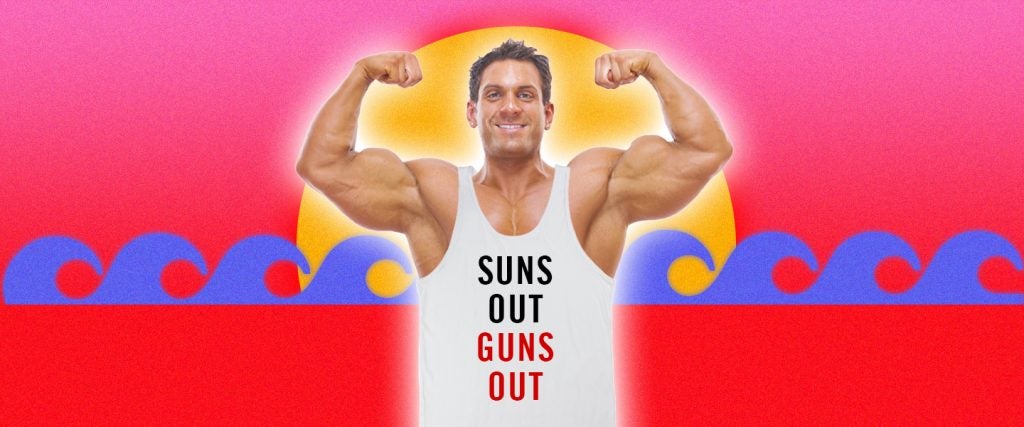It’s the week of Fourth of July. And while we appreciate you being here, we really hope it’s from some stretch of sand or some body of water relaxing enough that your problems can be put on the same kind of ice as the booze in the cooler next to you. If not, throw on your shades anyway, and join us for our weeklong package, “Life’s a Beach,” a celebration of all things sand, sun and summer. Of course, if you’re already on vacation, you’re welcome, too — just be sure to reapply another layer of sunscreen, as these pieces burn bright. Read all of them here.
Whether you’re camped out on the shore of a local beach or in a neighbor’s backyard enjoying a summer cookout, the mere sight of someone removing a light jacket or a hoodie to reveal their bare arms is going to elicit the familiar refrain of “Sun’s out, guns out!” from someone in the crowd.
The sun wasn’t necessarily shining, but the first time I remember guns being used in this context was during a promotional interview for the WWF’s 1991 Survivor Series event. While flanked by Bret Hart, Roddy Piper and Virgil, “The British Bulldog” Davey Boy Smith referred to his arms as “the 21-inch guns.”
The origin of biceps-as-guns, though, tie back to a much less muscular sport: baseball. The association seems to extend back to the earliest days of the national pastime, too, during which the coverage of national and local baseball games routinely shared newspaper space with reports from local gun clubs, and also national and international military actions. In fact, when the first pitching machine was introduced in 1896, it was referred to as a “baseball gun.”
A major syndicated report, “Handling the Big Guns of Baseball” from September 1911, referred specifically to major-league pitchers as “big guns,” and focused on how it was important for skilled catchers to accurately guide their cannon-strength arms. “Handling the big guns of baseball is no easy job,” stated the article. “It takes a certain man to do it, as it takes a trained marksman to make the guns of the Navy effective. The pitchers get all the credit and the glory, but the catchers are the marksmen who direct the fire of these big guns and train them to do the most deadly damage. Separate the big pitcher from his regular catcher, and it is like taking the negative electrode of a storage battery. It promptly loses its power to produce electricity.”
Similarly, a 1915 article from the Tulsa Democrat that deepened the link between the accuracy of baseball players’ arms and projectile weaponry was headlined “Baseball Arms More Accurate Than Guns.” “Just like a shot from a rifle… these fans would marvel still more if they knew that under the conditions the marksmanship of the outfielder was more accurate than would have been than of the average rifleman,” it explained.
Along these lines, during the heart of the Public Enemy era of American history in the 1920s — a period in which mobsters were regularly gunned down in public settings — the sports pages of major newspapers were replete with references to players being “gunned down” by fielders who threw them out as they attempted to take extra bases.
Sport aside, as we’ve heard ad nauseam in recent years, the Second Amendment of the Constitution states, “The right to keep and bear Arms, shall not be infringed.” The natural play on words between “bear arms” and “bare arms” led to newspapers making frequent reference to citizens capitalizing on their “right to bare arms” nearly every time a reference was made to a nudist colony, or any time a picture of a shirtless sunbather appeared on or around Fourth of July. Moreover, by the mid-1970s, it was pretty much impossible to find an advertisement for a tank top without the “right to bare arms” being playfully cited. Case in point:
When the early 1980s rolled around, many gym meatheads were already referring to their heavily muscled arms as “guns.” A November 1981 article from the Cedar Rapids Gazette explained how weightlifting coach Dan Goddard had helped to toughen up the University of Illinois football team ahead of the 1981 season, leading to the team’s victory over the Iowa Hawkeyes: “After the game, Goddard was stunned when [Coach Mike] White presented him the game ball, saying they won this one for Coach Guns. They call him ‘Coach Guns’ because of his huge arms and powerful physique. For those not in the know, muscle people call big arms ‘guns.’”
By 2000, several references to bicep flexing being like attending a “gun show” had already crept into American pop culture. This comparison rapidly took off after Will Ferrell flexed his unimpressive arms during the 2004 film Anchorman and affirmed, “The only way to bag a classy lady is to give her two tickets to the gun show.”
From there, it was only a matter of time before a phrase like “Sun’s out, guns out” was coined. It materialized on T-shirts and made its way into Urban Dictionary as early as 2006. And it went fully mainstream when Channing Tatum wore a sun’s-out-guns-out tank during a memorable scene from the 2014 movie 22 Jump Street.
Luckily, these kinds of guns don’t pose any type of real danger — except for those forced to suffer through the skips of their rapidly beating hearts.

